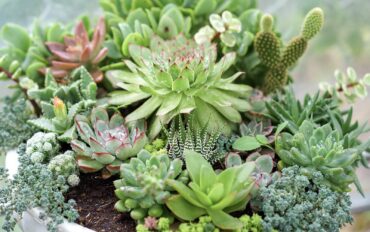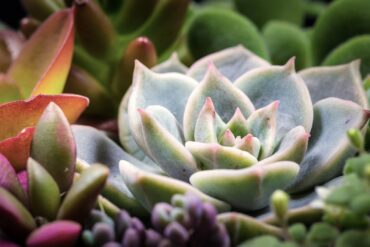 Bring low-maintenance beauty to your outdoor space with a succulent garden. Succulents are water-wise plants that thrive in sunlight, making them perfect for creating a stunning and easy-to-care-for outdoor oasis.
Bring low-maintenance beauty to your outdoor space with a succulent garden. Succulents are water-wise plants that thrive in sunlight, making them perfect for creating a stunning and easy-to-care-for outdoor oasis.
Bonus! Depending on your region and growing zone, you can bring many succulents indoors for the winter, giving you year-round pleasure.
Succulents are practical to have in your garden because they require little maintenance and are drought tolerant. Their leaves, stems and roots can store water, allowing them to withstand dry conditions or accidental neglect.
Succulents are also very adaptable, allowing them to grow in more challenging conditions and environments. Think about including them in containers, a window box or a rock garden.
Not only are they practical, but succulents also provide versatility in design with a wide variety of beautiful shapes, sizes and colors, allowing you to get creative in your garden. Adding succulents to your garden is a great way to enhance its overall beauty.
Easy steps to help you create a thriving succulent garden
Choose the right succulents: First, know your growing zone. Then select a variety of succulents that thrive in your climate. For example, sempervivum are hardy in zones 3-10 and sedums in zones 4-10, whereas echeveria are hardy in zones 9-11 but can be used as an annual elsewhere. Know your zone and choose accordingly.
Select the ideal location: Succulents generally prefer well-drained soil and plenty of sunlight. Choose a spot in your garden that receives at least six hours of sunlight per day. Make sure the area has good drainage to prevent waterlogging because succulents are prone to root rot if left in standing water.
Prepare the soil: Succulents thrive in sandy, well-drained soil. If your garden soil is heavy or clay-like, consider adjusting it with sand, perlite or gravel to improve drainage. Alternatively, you can create raised beds filled with a mix of succulent potting soil and coarse sand.
Style your garden: Arrange rocks and boulders, outdoor décor and even driftwood or seashells to create visually appealing levels and contours. This not only adds aesthetic appeal but also provides pockets for planting succulents.
 Planting and Care
Planting and Care
Planting succulents: Ensure that the holes are deep enough to accommodate the roots of the plants. Gently remove the succulents from their pots and place them in the holes. Backfill with soil and press gently to secure the plants in place.
Watering: Succulents are drought-tolerant plants, but they still need occasional watering, especially during the growing season. Water them deeply but infrequently, allowing the soil to dry out completely between waterings. Be careful not to overwater, as this can lead to root rot.
Maintenance: Keep an eye on your garden for any weeds that may try to invade. Remove them promptly to prevent competition for nutrients and water. Additionally, monitor your succulents for pests and diseases, and take appropriate action if any issues arise.
Winter care: In colder climates, consider planting your succulents in containers. Protect them from frost damage by providing some shelter or bringing potted succulents indoors during winter. Mulching around the plants can also help insulate the roots and protect them from freezing temperatures.
Plants That Compliment Succulents
Long gone are the days of the standard “green-only” options. Succulents now come in a wide variety of colors, textures, forms and heights. With such a vast assortment, making combinations is “as easy as pie.”
Here are some complementary and colorful tender plants that coexist harmoniously with succulents, adding bursts of color to your outdoor space.
Callas: Bring a vibrant pop of color and pair well with succulents because they can be grown indoors as well. In warmers climates, callas can also be used in the landscape along with succulents, creating a striking appearance.
Kalanchoes: Complement any succulent assortment with a twist on the traditional. They come in a wide variety of unique flower forms, colors and patterns. Kalanchoes are also an amazing indoor plant in the north and a landscape option for the south, making them as versatile as succulents.
Sit back, relax, and enjoy your newly created succulent garden. Watch the plants grow and thrive, bringing you joy and satisfaction in knowing that you have created a beautiful oasis right in your own backyard.
This post is provided as an educational/inspirational service of the National Garden Bureau and its members. Founded more than 100 years ago, the National Garden Bureau educates, inspires and motivates people to grow home gardens. National Garden Bureau members are horticultural experts, and the information shared with you comes directly from these experts to ensure your gardening success.


























